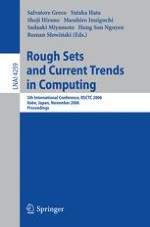2006 | Buch
Rough Sets and Current Trends in Computing
5th International Conference, RSCTC 2006 Kobe, Japan, November 6-8, 2006 Proceedings
herausgegeben von: Salvatore Greco, Yutaka Hata, Shoji Hirano, Masahiro Inuiguchi, Sadaaki Miyamoto, Hung Son Nguyen, Roman Słowiński
Verlag: Springer Berlin Heidelberg
Buchreihe : Lecture Notes in Computer Science
